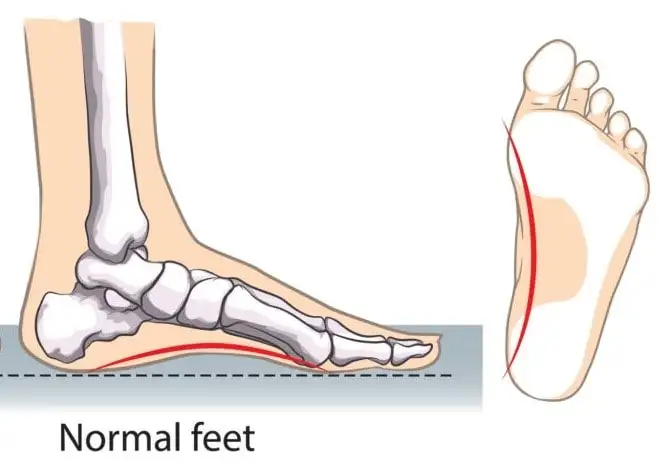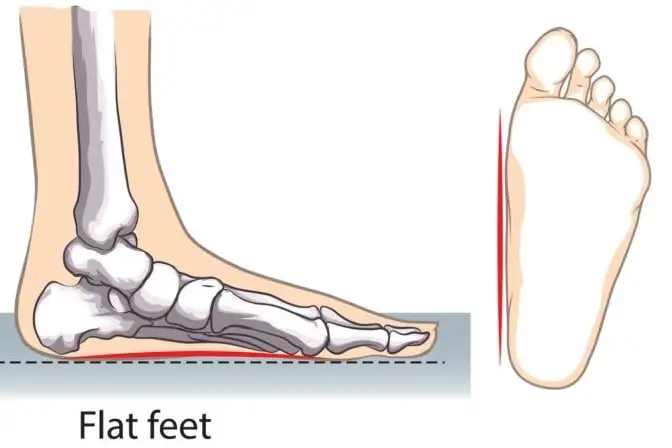FLAT FEET: a Curse or a Blessing in disguise
Flatfoot (aka flat feet aka pes planus) is real. It is not a disease; it is a physical condition.
It is not a curse, surely. Blessing? Read through the article and we will cover advantage of flatfeet.
Flatfoot is a very common foot condition where the arches on the inside of the feet flatten when pressure is put on feet; for example, while standing.
What is Flat Foot?
To understand flat feet, we need to understand the anatomy of human foot. Notice the arch in the foot (Figure 1).

Figure 1: Normal Anatomy of Human Foot
Now, inspect Figure 2, you will observe the arch as was present is now flattened. This is physiologically referred as Flat Feet or flatfoot. When a person stands, the pressure comes on the feet and entire soles touch the flooring.

Figure 2: Flat Foot
Flatfoot can occur during the childhood when the arches do not form or it can be an outcome of an injury or in case of elderly, normal wear & tear of muscles due to age.
One should note that all humans are born with flat feet as during birth the tissues (tendons) holding the foot together are loose. As we grow, these tissues tighten in the shape of an arch, typically by the age of 2-3 years.
Why flat feet an issue?
Flatfoot is a medical condition which needs treatment or medical guidance only if the patient develops painful symptoms. It is estimated that only about 30% of people having flat feet develop symptoms hence it isn’t an issue for 70% of patients.
Now, patients with symptoms may experience significant pain and having a flatfoot may affect the gait/walk of a person as the foot is not stable and its support is compromised due to collapsed arches.
As highlighted in above picture, Flat feet affects the complex movement algorithm of our feet and may lead to overpronation and or over-supination.
Types of Flat Feet
Flexible Flatfoot: This is the most common type of flat feet condition found among the patients. The arches are much visible when the patient is not standing and applying no pressure on feet. However, as pressure gets on the feet, the arches collapse.
Flexible flatfoot normally comes on during childhood or the teen years. Mostly observed in both feet, it gets worst with age.
Rigid: When the feet have no arches when the feet are under weight (for example: standing) nor are the arches visible while sitting, the condition is referred as Rigid Flat feet. Rigid Flatfoot normally develops during late teen years. This is often more painful than flexible flatfoot and affects movement. This condition may affect one or both feet.
Adult-acquired (fallen arch): With an adult-acquired flat foot (fallen arch), the foot's arch drops or collapses. It happens mostly due to an injury to the tissue or may be inflammation in the tendon. Since the condition develops over shorter period of time, the anatomy around the tendons do not adjust and this makes this as more painful condition.
Vertical talus: Babies may have a birth defect called vertical talus that prevents arches from forming. Under this type, the talus bone in the ankle is in incorrect position. Vertical talus is also called rocker-bottom foot as the bottom of the foot look like the bottom of a rocking chair.
Diagnosis
Diagnosis of flat feet is extremely important step as the specialist may decipher the cause of fallen arches. This will help in devising a customised treatment plan for the patient.
- Physical inspection - detailed inspection of the patient is done to identify the painful spots. A foot & ankle specialist will test the strength of ankles to identify the extent of issue.
- Specialist may inspect your footwear to identify the wear and tear zones on the footwear soles and identify if flat feet cause lead to overpronation or oversupination.
- Imaging test like x-ray, CT scan and/or MRI scan may be done to assess the internal position of the foot anatomy.
Treatment
If the patient is not experiencing any symptoms like pain or any issues with walking/gait or any imbalance issue, no specific treatment is required for flat feet condition.
For patients with symptoms, initially non-aggressive treatment plan is recommended, however depends on patient condition:
- Rest: Our feet bear our whole weight; flat feet does affect the overall structure of the foot to support the weight and hence doctors do recommend giving enough rest to feet to recover and heal.
- Weight Loss: In some situations where patient is obese, doctors do prefer weight loss to reduce stress on foot.
- Medication: Non-Steroidal Anti Inflammatory (NSAIDs) are prescribed to ease inflammation and pain.
- Physical Therapies: Doctor will explain some stretching exercises to improve flexibility and strength of feet and ankle.
- Orthotic devices (Arch supports): Arch supports can help relieve the pain and provide symptomatic relief to flatfeet patients. Arch supports won't cure flatfeet, but they often reduce symptoms. These support devices can be used with regular footwear.
Surgery
Surgery in extreme and rare cases is recommended only if the pain and other symptoms do not subside post non-surgical treatments and if patient is experiencing issues with routine activities.
Can Flat feet be prevented
No. Since no specific reason has yet been identified for the condition, we can not recommend any prevention protocol. Maintaining healthy weight is considered beneficial for this condition.
What is the Outlook for Flatfoot patients
Most patients do not need any treatment. Patients with symptoms will get relief with the non-surgical treatments and very few will need to consider intervention.
Consult Foot & Ankle Specialists to get yourself evaluated and have a customised treatment plan.
Now we want to highlight that it is not a condition which limits you from undertaking any activity.
Having flat feet gives you the unique ability as a sportsperson to absorb shock better as compared to someone with a high arch. This is because when landing the foot arch itself has more range of motion to control and absorb shock.
There is also a school of thought that flat feet may give swimmers support as the feet may take role of natural flippers.
Overall, there's absolutely NO evidence to prove that flat foot adversely affects to run fast or undertake any activity.
It is important to understand that people that are flat footed do need to strengthen their feet in order to run fast or have success in sports.
Just for information – Athletes like PT Usha, Ussain Bolt and countless others are Flat Footed. It highlights that the condition does not make any difference to your performance but it's the way you train & strengthen yourself.